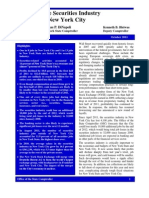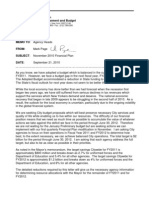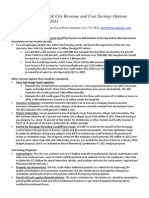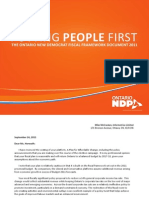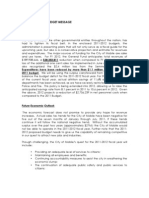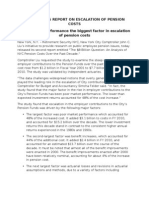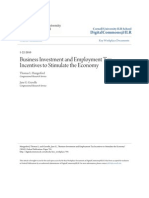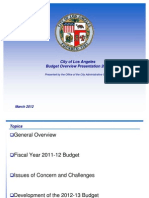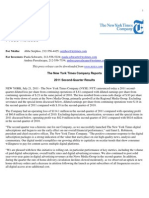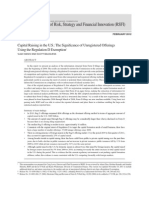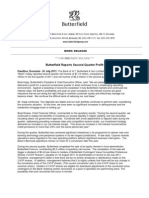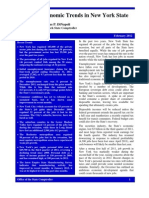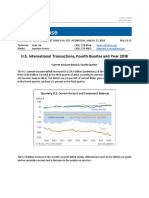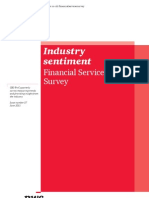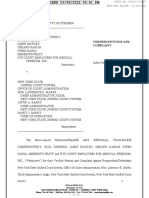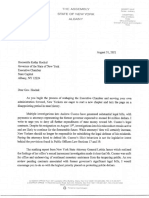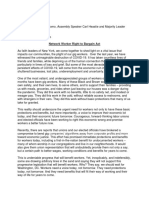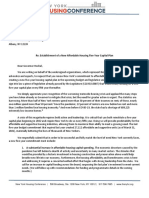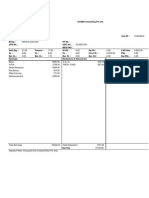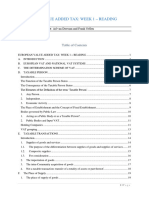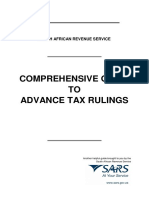Wall Street Bonus Release
Wall Street Bonus Release
Uploaded by
Nick ReismanCopyright:
Available Formats
Wall Street Bonus Release
Wall Street Bonus Release
Uploaded by
Nick ReismanCopyright
Available Formats
Share this document
Did you find this document useful?
Is this content inappropriate?
Copyright:
Available Formats
Wall Street Bonus Release
Wall Street Bonus Release
Uploaded by
Nick ReismanCopyright:
Available Formats
NEWS
CONTACT: Eric Sumberg (212) 681-4840
From the Office of New York State Comptroller
Thomas P. DiNapoli
FOR RELEASE: Embargoed
WALL STREET BONUSES DECLINED IN 2011
Industry Profits Down by Half from Prior Year Cash bonuses paid to New York City securities industry employees are forecast to decline by 14 percent to $19.7 billion during this years bonus season, according to an estimate released today by State Comptroller Thomas P. DiNapoli. Cash bonuses were down in 2011, reflecting a difficult year on Wall Street, DiNapoli said. Profits were down sharply and securities firms in New York City resumed downsizing in the second half of the year. The securities industry, which is a critical component of the economies of New York City and New York State, faces continued challenges as it works through the fallout from the financial crisis and adjusts to regulatory reforms. The Comptroller also estimates that profits for the broker/dealer operations of New York Stock Exchange member firms, the traditional measure of profitability for the securities industry, did not exceed $13.5 billion in 2011, which would be less than half of the $27.6 billion earned in 2010. This would be the second year in a row that profits dropped by more than half. While the industry had a strong first half with profits of $12.6 billion, it lost $3 billion during the third quarter. Underlying profitability at the large firms was even weaker than reported because profits were boosted by accounting adjustments. The industry earned a record $61.4 billion in 2009 with the benefit of federal assistance after losing a record total of $53.9 billion over the course of 2007 and 2008. While a number of large firms announced reductions in cash bonuses for 2011 (with several firms reporting reductions in the range of 20 to 30 percent), personal income tax collections indicate a smaller decline in the overall cash bonus pool. This is likely due to the payment of bonuses that had been deferred from earlier years. The increased use of deferred compensation should create a pipeline of bonuses that will be paid in future years, which will reduce volatility in industry tax payments. DiNapolis office releases an annual estimate of cash bonuses paid to securities industry employees who work in New York City during the traditional bonus season. Bonuses paid by New York Citybased firms to their employees located outside of the City (whether in domestic or international locations) are not included. The Comptrollers estimate is based on personal income tax trends and reflects cash bonuses and deferred compensation for which taxes have been withheld. The estimate does not include stock options or other forms of deferred compensation that have not been realized.
Albany Phone: (518) 474-4015 Fax: (518) 473-8940 NYC Phone: (212) 681-4840 Fax: (212) 681-4468 Internet: www.osc.state.ny.us E-Mail: press@osc.state.ny.us
DiNapoli also reported that: The securities industry in New York City has resumed downsizing. Between April 2011 and December 2011, the industry shed 4,300 jobs. During the financial crisis, the industry had lost 28,000 jobs, of which only 9,600 jobs had been recovered before losses resumed in April 2011. The average cash bonus declined by 13 percent to $121,150 in 2011. The average bonus declined slightly less than the total cash bonus pool because the pool was shared among fewer workers than in 2010. The average salary (including cash bonuses) in the securities industry in New York City grew by 16 percent to $361,180 in 2010, which was 5.5 times higher than the average salary in the rest of the private sector ($66,110). Data is not yet available for 2011. Compensation consumed a greater share of net revenue in 2011. The member firms of the New York Stock Exchange devoted nearly 52 percent of their net revenue to compensation (e.g., salary and bonuses for their broker/dealer operations) during the first three quarters of 2011, compared with 47 percent in all of 2010 and 36 percent in 2009. Before the start of the financial crisis, business and personal income tax collections from Wall Street related activities accounted for up to 20 percent of New York State tax revenues, but that contribution declined to 14 percent last year. Wall Streets contribution to the Citys tax collections has declined from 13 percent of City tax revenues to less than 7 percent. In 2010, the securities industry in New York City accounted for 23.5 percent of all wages paid in the private sector despite accounting for only 5.3 percent of all private sector jobs. The decline in bonuses forecast by the Comptroller is consistent with the expectations in New York Citys budget but is not as great as the decline predicted by New York State for the broader finance industry, meaning revenues may be slightly higher than anticipated in the last quarter of the current state fiscal year. ### Follow us on twitter: @NYSComptroller
You might also like
- Declaration of Revocation of ElectionDocument10 pagesDeclaration of Revocation of ElectionAkil Bey95% (42)
- OCM LawsuitDocument29 pagesOCM LawsuitNick Reisman100% (1)
- Matter of Demetriou V New York State Department of Health 2022-00532Document2 pagesMatter of Demetriou V New York State Department of Health 2022-00532Nick ReismanNo ratings yet
- The Securities Industry in New York City: Thomas P. DinapoliDocument4 pagesThe Securities Industry in New York City: Thomas P. DinapoliJimmyVielkindNo ratings yet
- The Securities Industry in New York City: Thomas P. DinapoliDocument8 pagesThe Securities Industry in New York City: Thomas P. DinapoliNick ReismanNo ratings yet
- Embargoed Securities Industry October 2013 ReportDocument8 pagesEmbargoed Securities Industry October 2013 ReportNick ReismanNo ratings yet
- Weekly Economic Commentary 5-09-12Document9 pagesWeekly Economic Commentary 5-09-12monarchadvisorygroupNo ratings yet
- Wall Street Rpt9-2013Document8 pagesWall Street Rpt9-2013Nick ReismanNo ratings yet
- City of Oakland Budget Facts 2011Document6 pagesCity of Oakland Budget Facts 2011oaklocNo ratings yet
- Quarterly Budget Report: City of ChicagoDocument14 pagesQuarterly Budget Report: City of ChicagoZoe GallandNo ratings yet
- 2021 Proposed Executive SummaryDocument9 pages2021 Proposed Executive SummaryThe UrbanistNo ratings yet
- Citi Hildebrandt 2012 Client AdvisoryDocument22 pagesCiti Hildebrandt 2012 Client AdvisoryJack HandyNo ratings yet
- Nov 2010 Financial Plan InstructionsDocument2 pagesNov 2010 Financial Plan InstructionsCeleste KatzNo ratings yet
- FPI FY2012RevenueOptionsDocument1 pageFPI FY2012RevenueOptionsfmauro7531No ratings yet
- Ontario New Democrat Fiscal FrameworkDocument16 pagesOntario New Democrat Fiscal FrameworkontarionewdemocratNo ratings yet
- Laborshare Perspectives 7Document52 pagesLaborshare Perspectives 7themaitreyNo ratings yet
- Economic Impact Analysis: Proposed New York State Tax Increases On Carried Interest of The Private Funds IndustryDocument28 pagesEconomic Impact Analysis: Proposed New York State Tax Increases On Carried Interest of The Private Funds IndustryCharles SwensonNo ratings yet
- Comptroller's DRAFT Audit of SchenectadyDocument19 pagesComptroller's DRAFT Audit of SchenectadyDavid LombardoNo ratings yet
- Mobile Mayor Sam Jones Proposed Budget For 2012Document25 pagesMobile Mayor Sam Jones Proposed Budget For 2012jamieburch75No ratings yet
- Review of The Financial Plan of The City of New York: December 2012Document32 pagesReview of The Financial Plan of The City of New York: December 2012Celeste KatzNo ratings yet
- Review of FY 2013 Mid-Year Budget Monitoring ReportDocument22 pagesReview of FY 2013 Mid-Year Budget Monitoring Reportapi-27500850No ratings yet
- IBO Budget AnalysisDocument17 pagesIBO Budget Analysishangman0000No ratings yet
- The Detroit BankruptcyDocument60 pagesThe Detroit BankruptcyWilliam J GreenbergNo ratings yet
- Nyt 3Q 2012 EarningsDocument11 pagesNyt 3Q 2012 EarningschouingmediaNo ratings yet
- Jpmorgan Chase & Co. 270 Park Avenue, New York, Ny 10017-2070 Nyse Symbol: JPMDocument17 pagesJpmorgan Chase & Co. 270 Park Avenue, New York, Ny 10017-2070 Nyse Symbol: JPMwompyfratNo ratings yet
- SP Report - Cincinnati OH - Nov 2012Document7 pagesSP Report - Cincinnati OH - Nov 2012COASTNo ratings yet
- NYC John Liu 8 BiillionfinalDocument3 pagesNYC John Liu 8 Biillionfinalfmauro7531No ratings yet
- Broyhill Letter (Q2-08)Document3 pagesBroyhill Letter (Q2-08)Broyhill Asset ManagementNo ratings yet
- Weekly Economic Commentary 01-30-12Document4 pagesWeekly Economic Commentary 01-30-12monarchadvisorygroupNo ratings yet
- 11 07 2012 EOTM Post Election ThoughtsDocument5 pages11 07 2012 EOTM Post Election ThoughtsForbesNo ratings yet
- Hunger Ford, TL - Business Investment and Employment Tax Incentives To Stimulate The EconomyDocument19 pagesHunger Ford, TL - Business Investment and Employment Tax Incentives To Stimulate The EconomytfjieldNo ratings yet
- Policy Matters Ohio - Tax Breaks For Wealthy and Special InterestsDocument4 pagesPolicy Matters Ohio - Tax Breaks For Wealthy and Special InterestsProgressOhio251No ratings yet
- CAFR DoxDocument2 pagesCAFR Doxjohn muhanda muNo ratings yet
- IDC Historic Rehabilitation Tax Credit Report - March 16, 2011Document16 pagesIDC Historic Rehabilitation Tax Credit Report - March 16, 2011robertharding22No ratings yet
- Annotated Bibliography Analyzes of JournalDocument3 pagesAnnotated Bibliography Analyzes of JournalSari HaryantiNo ratings yet
- 2010 Albany BudgetDocument187 pages2010 Albany BudgettulocalpoliticsNo ratings yet
- By: Akshaya (1020734) Amala Gadde (1020735) B. Madhulika (1020737 Mahija Reddy (1020758)Document32 pagesBy: Akshaya (1020734) Amala Gadde (1020735) B. Madhulika (1020737 Mahija Reddy (1020758)mahijayNo ratings yet
- Assignment 1 Outline and Guideline UpdateDocument4 pagesAssignment 1 Outline and Guideline UpdateĐan Nguyễn PhươngNo ratings yet
- City of Los Angeles Budget Overview Presentation 2012Document35 pagesCity of Los Angeles Budget Overview Presentation 2012Bill RosendahlNo ratings yet
- Enacted Budget Report 2020-21Document22 pagesEnacted Budget Report 2020-21Luke ParsnowNo ratings yet
- Zillow Inc: Form 8-KDocument15 pagesZillow Inc: Form 8-KJohn CookNo ratings yet
- Countdown To Zero FINALDocument10 pagesCountdown To Zero FINALtscupeNo ratings yet
- 2010-09-13 Chartwell Announces Financial Results For The Three Months Ended July 31, 2010Document3 pages2010-09-13 Chartwell Announces Financial Results For The Three Months Ended July 31, 2010Amaya GamingNo ratings yet
- Muni Rally May Continue, But Must Navigate Policy RisksDocument3 pagesMuni Rally May Continue, But Must Navigate Policy RisksPutnam InvestmentsNo ratings yet
- Q2 2011 EarningsDocument15 pagesQ2 2011 EarningsmelissatsangNo ratings yet
- Van Hoisington Letter, Q3 2011Document5 pagesVan Hoisington Letter, Q3 2011Elliott WaveNo ratings yet
- Capital Raising in The U.S. - The Significance of Unregistered Offerings Using The Regulation D ExemptionDocument9 pagesCapital Raising in The U.S. - The Significance of Unregistered Offerings Using The Regulation D ExemptionVanessa SchoenthalerNo ratings yet
- Q2 2011 - FinancialResultsDocument7 pagesQ2 2011 - FinancialResultspatburchall6278No ratings yet
- Corporatetaxdodgers 50 StatesreportDocument31 pagesCorporatetaxdodgers 50 Statesreportapi-242670092No ratings yet
- Detroit Creditor ProposalDocument65 pagesDetroit Creditor ProposalZerohedgeNo ratings yet
- Preqin Compensation and Employment Outlook Private Equity December 2011Document9 pagesPreqin Compensation and Employment Outlook Private Equity December 2011klaushanNo ratings yet
- Nys Econ Trends15-2012Document4 pagesNys Econ Trends15-2012jspectorNo ratings yet
- BoPs US 2018Document25 pagesBoPs US 2018Thắng Nguyễn HuyNo ratings yet
- Đáp Án NgheDocument29 pagesĐáp Án NgheChâu BảoNo ratings yet
- SAEDF Impact Report 2012Document2 pagesSAEDF Impact Report 2012Texas Public RadioNo ratings yet
- Moody's Report - Cincinnati OH - November 2012Document9 pagesMoody's Report - Cincinnati OH - November 2012COASTNo ratings yet
- Protecting Bonds To Save Infrastructure and Jobs (February 2013) : ReportDocument13 pagesProtecting Bonds To Save Infrastructure and Jobs (February 2013) : ReportDustin Tyler JoyceNo ratings yet
- Cbi Survey 87Document16 pagesCbi Survey 87Vibhu SharmaNo ratings yet
- Strategy Radar - 2012 - 0316 XX ChinamericaDocument3 pagesStrategy Radar - 2012 - 0316 XX ChinamericaStrategicInnovationNo ratings yet
- JP Morgam GDPDocument2 pagesJP Morgam GDPbubbleuppNo ratings yet
- Activities Related to Credit Intermediation Miscellaneous Revenues World Summary: Market Values & Financials by CountryFrom EverandActivities Related to Credit Intermediation Miscellaneous Revenues World Summary: Market Values & Financials by CountryNo ratings yet
- Business Credit Institutions Miscellaneous Revenues World Summary: Market Values & Financials by CountryFrom EverandBusiness Credit Institutions Miscellaneous Revenues World Summary: Market Values & Financials by CountryNo ratings yet
- Commercial Bank Revenues World Summary: Market Values & Financials by CountryFrom EverandCommercial Bank Revenues World Summary: Market Values & Financials by CountryNo ratings yet
- U.S. v. Brian Benjamin IndictmentDocument23 pagesU.S. v. Brian Benjamin IndictmentNick ReismanNo ratings yet
- E2022 0116cv Tim Harkenrider Et Al V Tim Harkenrider Et Al Decision After Trial 243Document18 pagesE2022 0116cv Tim Harkenrider Et Al V Tim Harkenrider Et Al Decision After Trial 243Nick ReismanNo ratings yet
- Amy Brignall Et Al V New York State Unified Court System Et Al - Filed PETITIONDocument56 pagesAmy Brignall Et Al V New York State Unified Court System Et Al - Filed PETITIONNick ReismanNo ratings yet
- Amy Brignall Et Al V New York State Unified Court System Et Al - Filed PETITIONDocument56 pagesAmy Brignall Et Al V New York State Unified Court System Et Al - Filed PETITIONNick ReismanNo ratings yet
- As Filed PetitionDocument67 pagesAs Filed PetitionNick ReismanNo ratings yet
- Letter - FL Region - Booster Healthcare Mandate 1-12-22Document2 pagesLetter - FL Region - Booster Healthcare Mandate 1-12-22Nick ReismanNo ratings yet
- EndorsementsDocument4 pagesEndorsementsNick ReismanNo ratings yet
- Lottery Commission Increase Letter To Governor HochulDocument3 pagesLottery Commission Increase Letter To Governor HochulNick ReismanNo ratings yet
- Contract c000271Document21 pagesContract c000271Nick ReismanNo ratings yet
- Letter To Gov Hochul 8.31Document2 pagesLetter To Gov Hochul 8.31Nick Reisman100% (1)
- Notice of Appeal Nassau County Mask RulingDocument8 pagesNotice of Appeal Nassau County Mask RulingNick ReismanNo ratings yet
- NY Gig Labor Clergy LetterDocument3 pagesNY Gig Labor Clergy LetterNick ReismanNo ratings yet
- Cuomo ReportDocument63 pagesCuomo ReportCasey Seiler100% (2)
- Covid 19 Executive Order To Limit Non Essential Elective Procedures 12-3-21Document3 pagesCovid 19 Executive Order To Limit Non Essential Elective Procedures 12-3-21News10NBCNo ratings yet
- SaveNYsSafetyNet SignOnLetter 02Document4 pagesSaveNYsSafetyNet SignOnLetter 02Nick ReismanNo ratings yet
- Hochul Housing Coalition Letter PrsDocument4 pagesHochul Housing Coalition Letter PrsNick ReismanNo ratings yet
- NY State Groups Sign-On Letter Supporting Biden's Tax & Investment Plans 8-9-21Document4 pagesNY State Groups Sign-On Letter Supporting Biden's Tax & Investment Plans 8-9-21Nick ReismanNo ratings yet
- CDPAP Budget Letter SigsDocument4 pagesCDPAP Budget Letter SigsNick ReismanNo ratings yet
- News Release Redistricting August 2021 FinalDocument2 pagesNews Release Redistricting August 2021 FinalNick ReismanNo ratings yet
- Accountability Waiver Announcement Memo 062221Document5 pagesAccountability Waiver Announcement Memo 062221Nick ReismanNo ratings yet
- S Ny 0621 Cross TabsDocument8 pagesS Ny 0621 Cross TabsNick ReismanNo ratings yet
- SNY0521 CrosstabsDocument7 pagesSNY0521 CrosstabsNick ReismanNo ratings yet
- OGS ResponseDocument1 pageOGS ResponseNick ReismanNo ratings yet
- AQE BuildingBackBetterDocument12 pagesAQE BuildingBackBetterNick ReismanNo ratings yet
- Cannabis and Scaffold LawDocument4 pagesCannabis and Scaffold LawNick ReismanNo ratings yet
- NYIVA State LetterDocument4 pagesNYIVA State LetterNick ReismanNo ratings yet
- TranscriptDocument3 pagesTranscriptNick Reisman100% (1)
- DeRosa TranscriptDocument40 pagesDeRosa TranscriptNick ReismanNo ratings yet
- SG 14e CHAP06Document22 pagesSG 14e CHAP06Viktor PirmanaNo ratings yet
- Akshay VasaniDocument1 pageAkshay Vasanipravin awalkondeNo ratings yet
- BUENAFE VS. COMELECDocument9 pagesBUENAFE VS. COMELECKWINZEL CONIYAT PACPACONGNo ratings yet
- SP AusNet 2014-17 Revenue ProposalDocument198 pagesSP AusNet 2014-17 Revenue ProposalpnrahmanNo ratings yet
- Reg No 75 2001 Tax Withholding Scheme Application CouncilDocument2 pagesReg No 75 2001 Tax Withholding Scheme Application CouncilbiniNo ratings yet
- Investment CompanyDocument16 pagesInvestment CompanyMd Abu Taher ChowdhuryNo ratings yet
- Rajaraman TaxDocument5 pagesRajaraman TaxsushilNo ratings yet
- Index 2010Document33 pagesIndex 2010SUNDEEP AGGARWALNo ratings yet
- Corruption: Delving Into The Muddy Water Through The Lens of IslamDocument9 pagesCorruption: Delving Into The Muddy Water Through The Lens of Islamgwnbyvhr9yNo ratings yet
- Condition TechniqueDocument15 pagesCondition TechniqueAndré TavaresNo ratings yet
- Handout 6 - Ethical IssuesDocument3 pagesHandout 6 - Ethical IssuesFJ AldeaNo ratings yet
- Ignou Fiscal Federalism 1Document16 pagesIgnou Fiscal Federalism 1luvlickNo ratings yet
- The Bamboo Bond IP 08 July 2011Document18 pagesThe Bamboo Bond IP 08 July 2011Antonio De GregorioNo ratings yet
- 2023 04 01 Harper's MagazineDocument84 pages2023 04 01 Harper's Magazinekalai100% (1)
- AmanDocument22 pagesAmanSantosh KeotNo ratings yet
- About The Student: This Se Ction A Sks For Importa NT Informa Tion A Bout The Stude NTDocument11 pagesAbout The Student: This Se Ction A Sks For Importa NT Informa Tion A Bout The Stude NTtop5 nepalNo ratings yet
- Latihan Soal PT CahayaDocument20 pagesLatihan Soal PT CahayaAisyah Sakinah PutriNo ratings yet
- ReportDocument3 pagesReportSrikanth ChakilelaNo ratings yet
- Rti DevDocument3 pagesRti DevPraveen RajNo ratings yet
- EU VAT Week 1 ReadingDocument35 pagesEU VAT Week 1 ReadinglunataspitukNo ratings yet
- LAPD-TAdm-G02 - Comprehensive Guide To Advance Tax RulingsDocument64 pagesLAPD-TAdm-G02 - Comprehensive Guide To Advance Tax RulingsKriben RaoNo ratings yet
- Establish and Maintain Cash Based Accounting SystemDocument31 pagesEstablish and Maintain Cash Based Accounting SystemTegene Tesfaye100% (1)
- IRPF 2022 2021 Origi Imagem Recibo01Document1 pageIRPF 2022 2021 Origi Imagem Recibo01BVC RoleplayNo ratings yet
- 222989_PRADIP ANNASAHEB SANGALE_Appointment Letter_04112022 - Pradip SangleDocument15 pages222989_PRADIP ANNASAHEB SANGALE_Appointment Letter_04112022 - Pradip SanglejayanthkalkatteNo ratings yet
- Sandisk Sddd3-032G-I35Gw 32 GB Otg Drive: Grand Total 579.00Document1 pageSandisk Sddd3-032G-I35Gw 32 GB Otg Drive: Grand Total 579.00Sk HabibullahNo ratings yet
- Name: - : InstructionsDocument4 pagesName: - : Instructionsjack truckNo ratings yet
- 06 Quiz 1Document1 page06 Quiz 1Angelo MorenoNo ratings yet
- Complete Philosophy Cash FlowDocument103 pagesComplete Philosophy Cash Flowjesus100% (13)
- Chapter-2: National Income Accounting: ContentsDocument89 pagesChapter-2: National Income Accounting: ContentsFaris KhalidNo ratings yet



